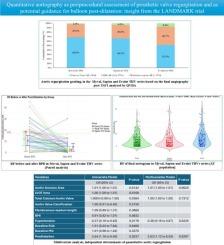Myval、Sapien和Evolut THV系列患者主动脉反流的定量视频密度评估:LANDMARK试验的结果
IF 2.5
Q2 CARDIAC & CARDIOVASCULAR SYSTEMS
引用次数: 0
摘要
定量视频密度主动脉造影(QVDA)可靠地量化了tavi后主动脉反流(AR)。然而,这种方法尚未在比较各种经导管心脏瓣膜(THV)系统的随机试验中得到评价。在这里,作为LANDMARK试验的一部分,我们研究了Myval、Sapien和Evolut THV系列患者在TAVI后急性主动脉瓣狭窄的QVDA。方法采用先进的CAAS-A-Valve 2.1.2软件对无球囊扩张或球囊扩张后的最终主动脉图像进行分析。计算返流分数(RF)并将其分为无/微量AR (RF < 86%)、轻度AR(6%≤8RF≤817%)和中度/重度AR (RF > 17%)。结果596张最终可分析主动脉图和97张BPD后主动脉图纳入分析。BPD导致Myval的RF显著降低[12.0(6.0-18.5)vs 2.0(1.0, 5.5)];p = 0.0002),组成[18.0(1.0 - -19.0)和2.0 (1.0 - -3.0);p = 0.04206)和Evolut[10.5(6.0 - -15.0)和5.0 (1.0 - -8.0);p = 0.0009]。Myval的最终RF率(2.0%)低于Evolut(8.00%),但与Sapien系列(4.0%)相似(PMyval-Sapien = 0.2333, PMyval-Evolut = 0.0057)。在处理后的种群中,Myval系列显示出与Sapien系列相当的RF,但与Evolut系列相比显着降低RF [Myval: 3.0% (1.0-7.0), Sapien: 3.0% (1.0-7.0), Evolut:5.0 %(1.0-10.0)], PMyval-Sapien = 0.8997,PMyval-Evolut = 0.0010]。结论QVDA显示Myval THV系列优于Evolut THV系列,在3种THV系列中,中/重度射频发生率最低,可与超声心动图配合使用,帮助发现无/微量AR。本文章由计算机程序翻译,如有差异,请以英文原文为准。

Quantitative videodensitometric assessment of aortic regurgitation in Myval, Sapien, and Evolut THV series: Results from the LANDMARK trial
Background
The quantitative videodensitometric aortography (QVDA) has reliably quantified post-TAVI aortic regurgitation (AR). However, this method has not yet been evaluated in randomized trials comparing various transcatheter heart valve (THV) systems. Here, we investigated the QVDA of AR following TAVI for severe aortic stenosis among Myval, Sapien, and Evolut THV series as part of the LANDMARK trial.
Methods
The final aortograms, either without or after balloon post-dilatation (BPD) were analyzed using the advanced CAAS-A-Valve 2.1.2 software. The regurgitant fraction (RF) was computed and categorized into none/trace AR (RF < 86 %), mild AR (6 % ≤ 8RF ≤ 817 %), and moderate/severe AR (RF > 17 %).
Results
Five hundred ninety-six final analyzable aortograms and 97 aortograms following BPD were included in the analysis. The BPD resulted in a significant reduction of RF in the Myval [12.0(6.0–18.5) vs 2.0(1.0, 5.5);p = 0.0002], Sapien[18.0(1.0–19.0) vs. 2.0(1.0–3.0); p = 0.04206] and Evolut [10.5 (6.0–15.0) vs 5.0 (1.0–8.0); p = 0.0009]. The rate of final RF > 17 % was lower in the Myval(2.0 %) compared to Evolut(8.00 %), but similar to the Sapien series (4.0 %)(PMyval-Sapien = 0.2333, PMyval-Evolut = 0.0057). In the as-treated population, the Myval series demonstrated a comparable RF to the Sapien series, but a significantly lower RF compared to the Evolut [Myval: 3.0 %(1.0–7.0), Sapien:3.0 %(1.0–7.0), Evolut:5.0 %(1.0–10.0)], PMyval-Sapien = 0.8997,PMyval-Evolut = 0.0010].
Conclusion
The QVDA highlights the superior performance of the Myval THV series compared to the Evolut THV series, with the lowest rate of moderate/severe RF among the three THV series, and could be used with echocardiography to help in detecting cases with none/trace AR.
求助全文
通过发布文献求助,成功后即可免费获取论文全文。
去求助
来源期刊

IJC Heart and Vasculature
Medicine-Cardiology and Cardiovascular Medicine
CiteScore
4.90
自引率
10.30%
发文量
216
审稿时长
56 days
期刊介绍:
IJC Heart & Vasculature is an online-only, open-access journal dedicated to publishing original articles and reviews (also Editorials and Letters to the Editor) which report on structural and functional cardiovascular pathology, with an emphasis on imaging and disease pathophysiology. Articles must be authentic, educational, clinically relevant, and original in their content and scientific approach. IJC Heart & Vasculature requires the highest standards of scientific integrity in order to promote reliable, reproducible and verifiable research findings. All authors are advised to consult the Principles of Ethical Publishing in the International Journal of Cardiology before submitting a manuscript. Submission of a manuscript to this journal gives the publisher the right to publish that paper if it is accepted. Manuscripts may be edited to improve clarity and expression.
 求助内容:
求助内容: 应助结果提醒方式:
应助结果提醒方式:


